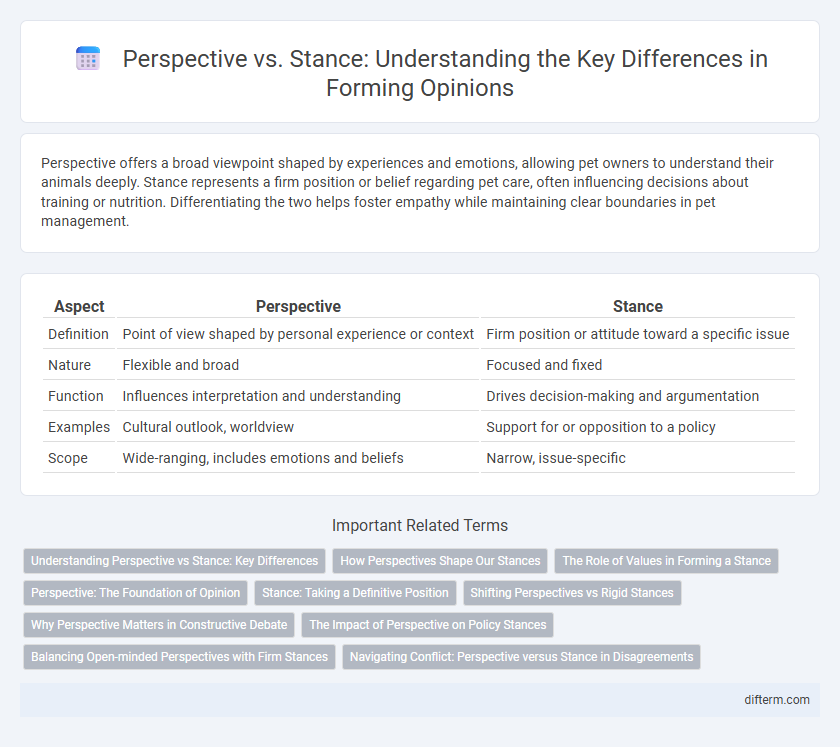Perspective offers a broad viewpoint shaped by experiences and emotions, allowing pet owners to understand their animals deeply. Stance represents a firm position or belief regarding pet care, often influencing decisions about training or nutrition. Differentiating the two helps foster empathy while maintaining clear boundaries in pet management.
Table of Comparison
| Aspect | Perspective | Stance |
|---|---|---|
| Definition | Point of view shaped by personal experience or context | Firm position or attitude toward a specific issue |
| Nature | Flexible and broad | Focused and fixed |
| Function | Influences interpretation and understanding | Drives decision-making and argumentation |
| Examples | Cultural outlook, worldview | Support for or opposition to a policy |
| Scope | Wide-ranging, includes emotions and beliefs | Narrow, issue-specific |
Understanding Perspective vs Stance: Key Differences
Understanding perspective involves recognizing an individual's or group's worldview shaped by experiences, beliefs, and emotions, whereas stance refers to the explicit position or attitude taken on a specific issue or topic. Perspective offers a broader, more subjective lens through which information is interpreted, while stance represents a concrete, often publicly declared viewpoint. Distinguishing between these concepts is crucial for effectively analyzing opinions and arguments in discussions or debates.
How Perspectives Shape Our Stances
Perspectives are the lenses formed by individual experiences, beliefs, and values, fundamentally shaping how we interpret information and events. Our stances emerge as explicit positions derived from these underlying perspectives, influencing decisions and interactions with others. Understanding the dynamic relationship between perspectives and stances reveals the complexity of opinions in social, political, and personal contexts.
The Role of Values in Forming a Stance
Values serve as the foundation for forming a stance, shaping how individuals prioritize issues and interpret information through their personal and cultural beliefs. Unlike a mere perspective, which may be neutral or observational, a stance reflects a committed position grounded in these deeply held values. Understanding the role of values clarifies why stances are often more emotionally charged and less flexible than perspectives.
Perspective: The Foundation of Opinion
Perspective shapes how individuals interpret information, serving as the foundation upon which opinions are built. It encompasses personal experiences, cultural background, and cognitive biases that influence perception and judgment. Understanding perspective allows for deeper insight into the origin and validity of differing opinions.
Stance: Taking a Definitive Position
A stance involves adopting a clear and unwavering position on a particular issue, reflecting a deep commitment to specific beliefs or values. Unlike a general perspective, a stance requires articulating definitive arguments that support the position and anticipating potential counterarguments. This decisive approach enhances credibility and drives purposeful action within debates and decision-making processes.
Shifting Perspectives vs Rigid Stances
Shifting perspectives allow individuals to adapt and grow by considering new information and diverse viewpoints, fostering open-mindedness and empathy. In contrast, rigid stances often lead to polarization and misunderstandings, as they resist change and reinforce cognitive biases. Embracing flexible perspectives promotes dialogue and innovation, while fixed stances can hinder constructive communication and problem-solving.
Why Perspective Matters in Constructive Debate
Perspective matters in constructive debate because it broadens understanding beyond fixed stances, allowing participants to consider diverse viewpoints and underlying motivations. Emphasizing perspective fosters empathy and critical thinking, which are crucial for identifying common ground and innovative solutions. This approach transforms debates from confrontations into collaborative dialogues, enhancing problem-solving effectiveness.
The Impact of Perspective on Policy Stances
Perspective shapes the foundation upon which policy stances are built, influencing how issues are interpreted and prioritized. Different cultural, social, and economic backgrounds lead to varied outlooks that determine the direction and intensity of policy commitments. Recognizing the impact of perspective allows policymakers to better navigate conflicting stances and create more inclusive, effective solutions.
Balancing Open-minded Perspectives with Firm Stances
Balancing open-minded perspectives with firm stances requires recognizing the value of diverse viewpoints while maintaining clear principles that guide decision-making. Embracing cognitive flexibility can enhance critical thinking and foster constructive dialogue without compromising core beliefs. This equilibrium supports adaptive problem-solving and strengthens interpersonal relationships by respecting differing opinions alongside steadfast commitments.
Navigating Conflict: Perspective versus Stance in Disagreements
Navigating conflict effectively requires distinguishing between perspective and stance, as perspectives represent underlying beliefs or values while stances convey expressed positions or attitudes in disagreements. Recognizing that perspectives often shape stances can lead to deeper understanding and more productive dialogues in resolving disputes. Emphasizing empathy and active listening allows conflicting parties to bridge gaps between opposing stances by appreciating diverse perspectives.
perspective vs stance Infographic

 difterm.com
difterm.com